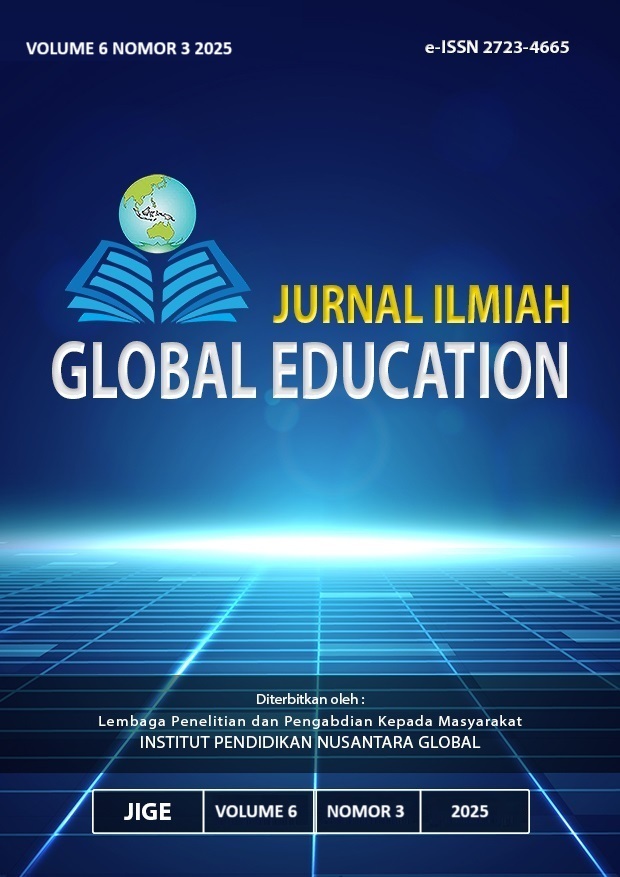Pengaruh Model Pembelajaran Kooperatif Tipe Two Stay Two Stray Terhadap Hasil Belajar IPAS Siswa Kelas V SDN Tengah 03
DOI:
https://doi.org/10.55681/jige.v6i3.3891Keywords:
Two Stay Two Stray, IPAS, Learnig Outcomes, Elementary schoolAbstract
This study aims to determine the effect of the Two Stay Two Stray type cooperative learning model on the learning outcomes of fifth grade students of SDN Tengah 03. This research uses a quantitative approach with a pseudo-experimental design type of nonequivalent control group design. The sample consisted of two classes, each consisting of 30 students, namely the experimental class and the control class. Data collection was carried out through pretest and posttest in the form of 10 essay questions to measure student learning outcomes in IPAS subjects. Data analysis was carried out through normality, homogeneity, and hypothesis testing with Independent Sample T-Test. The results of the analysis showed that the average value of the experimental class posttest (84.33) was higher than the control class (58.83). Hypothesis testing showed a significance value of <0.001, which indicates a significant difference between groups. This study concludes that the Two Stay Two Stray model significantly improves learning outcomes, creates an active and collaborative atmosphere, and has a real impact on student academic achievement at SDN Tengah 03. The findings recommend the application of this model by teachers to create fun and effective learning.
Downloads
References
Amin, N. F., Garancang, S., Abunawas, K., Makassar, M., Negeri, I., & Makassar, A. (2023).
PENDAHULUAN Penelitian merupakan proses kreatif untuk mengungkapkan suatu gejala melalui cara tersendiri sehingga diperoleh suatu informasi . Pada dasarnya , informasi tersebut merupakan jawaban atas masalah-masalah yang dipertanyakan sebelumnya . Oleh ka. 14(1), 15–31.
Harahap, M. S., Lubis, R., & Harahap, L. A. (2020). Efektivitas Model Pembelajaran Kooperatif Tipe
Two Stay Two Stray (Tsts) Terhadap Kemampuan Pemecahan Masalah Matematis Siswa. Jurnal Pendidikan Matematika SIGMA, 12(2), 148–160.
Haryono, E., Slamet, M., & Septian, D. (2023). Statistika SPSS 28. PT Elexmedia Komputindo. Jakarta.,
–23.
Hastjarjo, T. D. (2019). Rancangan Eksperimen-Kuasi. Buletin Psikologi, 27(2), 187.
https://doi.org/10.22146/buletinpsikologi.38619
Inovasi, J., Pendidik, T., & Vol, K. (2022). No Title. 2(4), 422–427.
Novitasari, D. (2019). Skripsi model pembelajaran two stay two stray untuk meningkatkan hasil
belajar ips di siswa kelas v mim hadimulyo tahun pelajaran 2018/2019.
Palupi, R., Yulianna, D. A., & Winarsih, S. S. (2021). Analisa Perbandingan Rumus Haversine Dan
Rumus Euclidean Berbasis Sistem Informasi Geografis Menggunakan Metode Independent Sample t-Test. JITU : Journal Informatic Technology And Communication, 5(1), 40–47. https://doi.org/10.36596/jitu.v5i1.494
Pramesti, D., & Wardani, E. F. (2023). Jurnal pendidikan ips. 13(1), 1–7.
Rosyid, A., & Mubin, F. (2024). Pembelajaran Abad 21: Melihat Lebih Dekat Inovasi Dan
Implementasinya Dalam Konteks Pendidikan Indonesia. Tarbawi : Jurnal Pemikiran Dan Pendidikan Islam, 7(1), 1–12. https://doi.org/10.51476/tarbawi.v7i1.586
Siswa, K. B. (2021). IRSYADUNA: Jurnal Studi Kemahasiswaan Vol. 1, No. 1, April 2021 P-ISSN : - ; E-
ISSN : - https://jurnal.stituwjombang.ac.id/index.php/irsyaduna. 1(1), 1–13.
Yusnaldi, E., Aulia, D., Panjaitan, F., Pasaribu, F., Sabina, L., Mustika, N., & Adelia, R. W. (2023).
Hakikat Pembelajaran Ilmu Pengetahuan Sosial. 7, 32175–32181.
Downloads
Published
How to Cite
Issue
Section
License
Copyright (c) 2025 Tri Nadia Julyani, Kasriman

This work is licensed under a Creative Commons Attribution-ShareAlike 4.0 International License.












